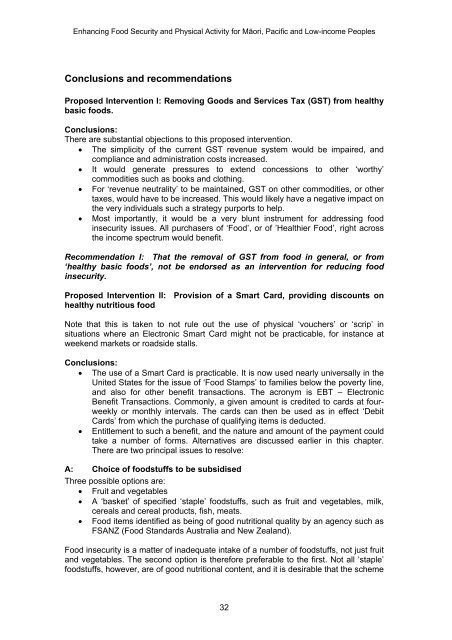enhancing food security and physical activity for maori, pacific and ...
enhancing food security and physical activity for maori, pacific and ...
enhancing food security and physical activity for maori, pacific and ...
- No tags were found...
Create successful ePaper yourself
Turn your PDF publications into a flip-book with our unique Google optimized e-Paper software.
Enhancing Food Security <strong>and</strong> Physical Activity <strong>for</strong> Māori, Pacific <strong>and</strong> Low-income PeoplesConclusions <strong>and</strong> recommendationsProposed Intervention I: Removing Goods <strong>and</strong> Services Tax (GST) from healthybasic <strong>food</strong>s.Conclusions:There are substantial objections to this proposed intervention.• The simplicity of the current GST revenue system would be impaired, <strong>and</strong>compliance <strong>and</strong> administration costs increased.• It would generate pressures to extend concessions to other ‘worthy’commodities such as books <strong>and</strong> clothing.• For ‘revenue neutrality’ to be maintained, GST on other commodities, or othertaxes, would have to be increased. This would likely have a negative impact onthe very individuals such a strategy purports to help.• Most importantly, it would be a very blunt instrument <strong>for</strong> addressing <strong>food</strong>in<strong>security</strong> issues. All purchasers of ‘Food’, or of ’Healthier Food’, right acrossthe income spectrum would benefit.Recommendation I: That the removal of GST from <strong>food</strong> in general, or from‘healthy basic <strong>food</strong>s’, not be endorsed as an intervention <strong>for</strong> reducing <strong>food</strong>in<strong>security</strong>.Proposed Intervention II: Provision of a Smart Card, providing discounts onhealthy nutritious <strong>food</strong>Note that this is taken to not rule out the use of <strong>physical</strong> ‘vouchers’ or ‘scrip’ insituations where an Electronic Smart Card might not be practicable, <strong>for</strong> instance atweekend markets or roadside stalls.Conclusions:• The use of a Smart Card is practicable. It is now used nearly universally in theUnited States <strong>for</strong> the issue of ‘Food Stamps’ to families below the poverty line,<strong>and</strong> also <strong>for</strong> other benefit transactions. The acronym is EBT – ElectronicBenefit Transactions. Commonly, a given amount is credited to cards at fourweeklyor monthly intervals. The cards can then be used as in effect ‘DebitCards’ from which the purchase of qualifying items is deducted.• Entitlement to such a benefit, <strong>and</strong> the nature <strong>and</strong> amount of the payment couldtake a number of <strong>for</strong>ms. Alternatives are discussed earlier in this chapter.There are two principal issues to resolve:A: Choice of <strong>food</strong>stuffs to be subsidisedThree possible options are:• Fruit <strong>and</strong> vegetables• A ‘basket’ of specified ‘staple’ <strong>food</strong>stuffs, such as fruit <strong>and</strong> vegetables, milk,cereals <strong>and</strong> cereal products, fish, meats.• Food items identified as being of good nutritional quality by an agency such asFSANZ (Food St<strong>and</strong>ards Australia <strong>and</strong> New Zeal<strong>and</strong>).Food in<strong>security</strong> is a matter of inadequate intake of a number of <strong>food</strong>stuffs, not just fruit<strong>and</strong> vegetables. The second option is there<strong>for</strong>e preferable to the first. Not all ‘staple’<strong>food</strong>stuffs, however, are of good nutritional content, <strong>and</strong> it is desirable that the scheme32
















